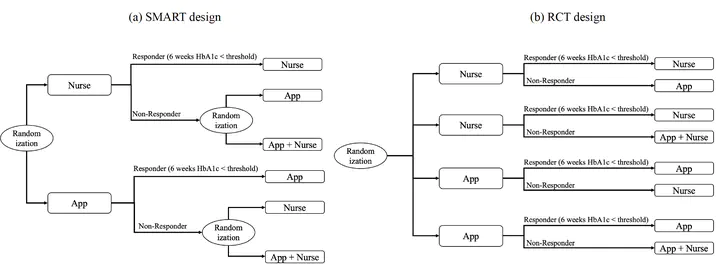Sequential Multiple Assignment Randomized Trial (SMART) to identify optimal sequences of telemedicine interventions for improving initiation of insulin therapy: A simulation study
 RCT and SMART Comparison
RCT and SMART Comparison
Abstract
Background To examine the value of a Sequential Multiple Assignment Randomized Trial (SMART) design compared to a conventional randomized control trial (RCT) for telemedicine strategies to support titration of insulin therapy for Type 2 Diabetes Mellitus (T2DM) patients new to insulin.
Methods Microsimulation models were created in R using a synthetic sample based on primary data from 63 subjects enrolled in a pilot study of a smartphone application (App), Diabetes Pal compared to a nurse-based telemedicine strategy (Nurse). For comparability, the SMART and an RCT design were constructed to allow comparison of four (embedded) adaptive interventions (AIs).
Results In the base case scenario, the SMART has similar overall mean expected HbA1c and cost per subject compared with RCT, for sample size of n = 100 over 10,000 simulations. SMART has lower (better) standard deviations of the mean expected HbA1c per AI, and higher efficiency of choosing the correct AI across various sample sizes. The differences between SMART and RCT become apparent as sample size decreases. For both trial designs, the threshold value at which a subject was deemed to have been responsive at an intermediate point in the trial had an optimal choice (i.e., the sensitivity curve had a U-shape). SMART design dominates the RCT, in the overall mean HbA1c (lower value) when the threshold value is close to optimal.
Conclusions SMART is suited to evaluating the efficacy of different sequences of treatment options, in addition to the advantage of providing information on optimal treatment sequences.